In the silent film, we often encounter fictitious kingdoms, principalities and duchies, with illustrious names such as Illyria, Silistria, Belgravia, Florania, and so on. Often, these kingdoms are ruled by old-fashioned monarchs, often dressed in full regalia and surrounded by men in impressive uniforms, while the countries are located somewhere in Central or Eastern Europe. Sometimes there are dictatorial rulers on the throne who must be replaced by more liberal ones. When old rulers die, a power struggle invariably ensues between good and bad pretenders to the throne (The Prisoner of Zenda, Carnevalesca). Other times, especially in comedy, the rulers tire of their royal straitjacket and escape to freer lands or go incognito among the 'common people' (Julot der Apache, Fürst Seppl). In dramas, relationships of princes with ordinary people end badly especially when the princes become kings (All'ombra di un trono, Ma l'amor mio non muore, The Student Prince), but in comedies, anything is possible (The Merry Widow), especially when the commoner becomes very rich and money talks. The aristocracy always needs money. The plots were at times based on popular stage operettas such as 'Die lustige Witwe' and 'Der Graf von Luxembourg'. In addition, both the Viennese and Russian czarist courts often function as a kind of Ruritania which has little to do with Austrian or Russian reality: Vienna for instance in Von Stroheim's The Wedding March and Russia in The Eagle with Rudolph Valentino. Sometimes, Ruritania has a queen as ruler, either a social climber who has proven her validity in emergency situations (Sofia di Kravonia) or a despotic woman who humiliates her common competitors (Queen Kelly) or proves to have a heart after all (Forbidden Paradise). In Ruritania, anything is possible.

German postcard by Ross Verlag, no. 98/9. Photo: Metro-Goldwyn-Mayer. Ramon Novarro in The Student Prince/The Student Prince in Old Heidelberg (Ernst Lubitsch, 1927).

German postcard by Ross Verlag, no. 4131/1, 1929-1930. Photo: Metro-Goldwyn-Mayer. Renée Adorée and Ramon Novarro in Forbidden Hours (Harry Beaumont, 1928).

German postcard by Ross Verlag, no. 697/5, 1919-1924. Photo: BAFAG (British-American-Films A.G.). Ramon Novarro and Barbara la Marr in The Prisoner of Zenda (Rex Ingram, 1922).
Outfits (on stage)
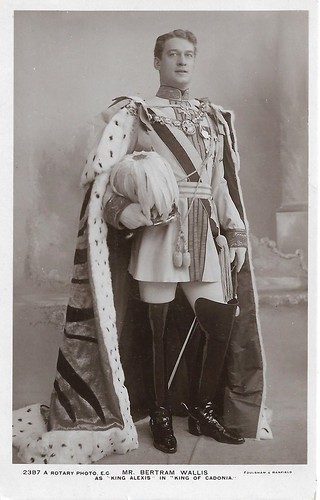
British postcard by Rotary Photo E.C., no. 2387 A. Photo: Foulsham & Banfield. Bertram Wallis as King Alexis in the play 'King of Cadonia'.
Power struggles
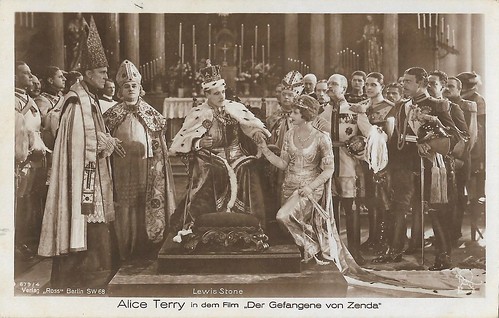
German postcard by Ross Verlag, no. 679/4. Lewis Stone as Rudolph Rassendyll and Alice Terry as Princess Flavia in The Prisoner of Zenda (Rex Ingram, 1922). The Bismarck-like guy behind Terry is the actor Robert Edeson, who plays Colonel Sapt. Behind him is actor Malcolm McGregor, who plays Captain Fritz von Tarlenheim. Both are the loyal aids of the King, defending him against his evil half-brother Michael (Stuart Holmes, who might be the man in black on the right) and his plotting cronies: his mistress Antoinette (Barbara la Marr) and Rupert von Hentzau (Ramon Novarro). Trying to stop a coup by Michael, who has abducted and imprisoned the real king, Sapt and Tarlenheim arrange a lookalike cousin of the king to be crowned (which we see on this card). The substitute king falls in love with Princess Flavia but he cannot tell the truth... Stone played both the King and his lookalike.

Spanish postcard by Amattler Marca Luna chocolate, series 7, no. 16. Lyda Borelli and Livio Pavanelli in Carnevalesca/Carnevalesque (Amleto Palermi, 1918), after Lucio d'Ambra. Photography was by Giovanni Grimaldi. Carlo abhors when he discovers his poisonous lies have Maria Teresa made killing her husband, Prince Pietro.
Escaping the straightjacket

French postcard by Editions Cinémagazine, no. 196. Photo: Luciano Albertini in Julot, der Apache (Joseph Delmont, Hertha von Walther, 1921), released in France as Julot l'apache but also as Le roi de Paris.

German postcard by Verlag Herm. Leiser, Berlin-Wilm., no. 9331. Erich Kaiser-Titz in Fürst Seppl/Prince Seppl (Carl Froehlich, 1915).

German postcard by Verlag Hermann Leiser, Berlin, no. 3254. Photo: Alba-Film. Stella Harf and Bruno Kastner in Die Fürstin von Beranien/The Princess of Berania (Ernst Reicher, 1918).
Doomed relationships

Italian postcard by G.B. Falci, Milano, no. 112. Photo: Films Gallone. Soava Gallone in All'ombra di un trono (Carmine Gallone, 1921). The film was based on a novel by Charles Folly, 'Fleur d'ombre'. When the legitimate heir to a throne has mysteriously killed himself, his brother (Piero Schiavazzi) becomes king. The iron law obliges the young and inexpert prince to abandon his affair with a bourgeois girl (Gallone), with whom he is in love. The renouncement of (but then revocation) of real love, the court intrigues, and a final duel are the ingredients of this Ruritania-like story. The film was released in Italy only in 1923. While the press thought it was outdated, audiences flocked to see it.

Spanish minicard by Reclam Films, Mallorca, no. 6. Photo: Gloria Film. Lyda Borelli and Mario Bonnard in the Italian silent film Ma l'amor mio non muore/Love everlasting (Mario Caserini, 1913). It was Lyda Borelli's screen debut.

German postcard by Ross Verlag, no. 98/12. Photo: Metro-Goldwyn-Mayer. Ramon Novarro in The Student Prince/The Student Prince in Old Heidelberg (Ernst Lubitsch, 1927).
Comedy
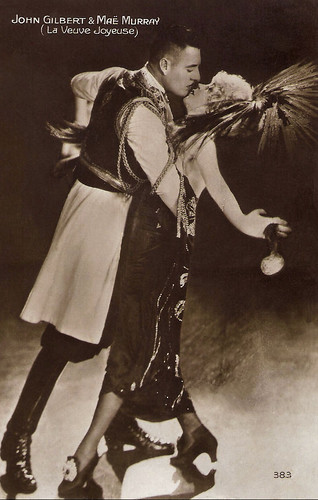
French postcard by Cinémagazine-Edition, Paris, no. 383. Photo: Metro-Goldwyn-Film. John Gilbert and Mae Murray in The Merry Widow (Erich von Stroheim, 1925).

Italian postcard by G.B. Falci, Milano, no. 529. Photo: Metro-Goldwyn-Film, Roma. Mae Murray and John Gilbert in The Merry Widow (Erich von Stroheim, 1925). The Italian title was La Vedova Allegra.
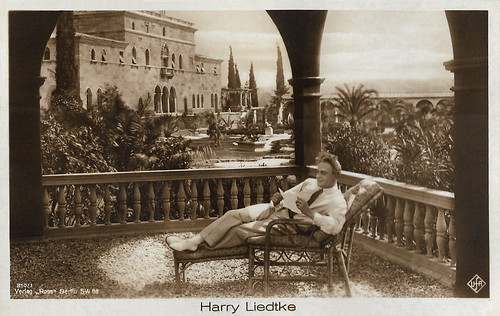
German postcard by Ross Verlag, no. 810/1. Photo: Ufa. Harry Liedtke in Die Finanzen des Großherzogs/The Grand Duke's Finances (F. W. Murnau, 1924).
Operetta as source

Swedish postcard by Axel Eliassons Konstförlag, Stockholm no. 997, 1907. Carl Barcklind as Count Danilo in 'Den glana änkan' (The Merry Widow).

British postcard by Rotary Photo, E.C., no. 4827 H. Photo: Foulsham & Banfield, Ltd. Lily Elsie as Sonia and Joseph Coyne as Prince Danilo in 'The Merry Widow'. In 1907, Edwardian music hall singer and actress Lily Elsie and American-born vaudevillian and musical comedy actor Joseph Coyne conquered British audiences overnight in 1907 with their roles in George Edwardes' London adaptation of 'The Merry Widow'. This led to other leading roles in Edwardian musical comedy and many other productions in London, New York, and Australia.

British postcard by Rotary Photo, E.C., no. 11784 C. Photo: Foulsham & Banfield, Ltd. Bertram Wallis and Lily Elsie in 'The Count of Luxembourg', an operetta in two acts with English lyrics and libretto by Basil Hood and Adrian Ross, music by Franz Lehár, based on Lehár's three-act German operetta 'Der Graf von Luxemburg' which had premiered in Vienna in 1909. The original production opened at Daly's Theatre in London in 1911 and ran for 345 performances, starring Lily Elsie, Huntley Wright, W. H. Berry, and Bertram Wallis.
Vienna and Russia

Italian card for the Il Cinema Ritrovato festival. Photo: Fay Wray and Erich von Stroheim in The Wedding March (Erich von Stroheim, 1928).

German postcard by Ross Verlag, no. 3677/1, 1928-1929. Photo: United Artists. Rudolph Valentino and Louise Dresser in The Eagle (Clarence Brown, 1925).
Queens

Spanish collectors card by Chocolate Imperiale, no. 4 out of 6 cards. Photo: Pasquali / Vay Film / J. Verdaguer / Prod. Armando Vay, Milano. Diana Karenne and Angelo Ferrari in Sofia di Kravonia (Ernesto Maria Pasquali, 1916), based on the book by Anthony Hope.
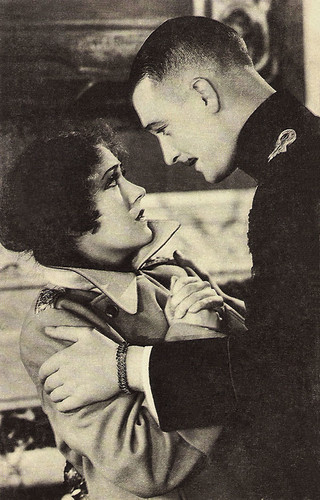
Spanish postcard by Casa Molina, Madrid. Gloria Swanson and Walter Byron in Queen Kelly (Erich von Stroheim, 1929).

German postcard by Ross Verlag, no. 1523/3, 1927-1928. Photo: Parufamet. Pola Negri in Forbidden Paradise (Ernst Lubitsch, 1924).

Spanish collectors card in the Series Intimidades de artistas de cine. Caption: The interrupted final scene. Rod La Rocque and Pola Negri in Forbidden Paradise (Ernst Lubitsch, 1924).
No comments:
Post a Comment